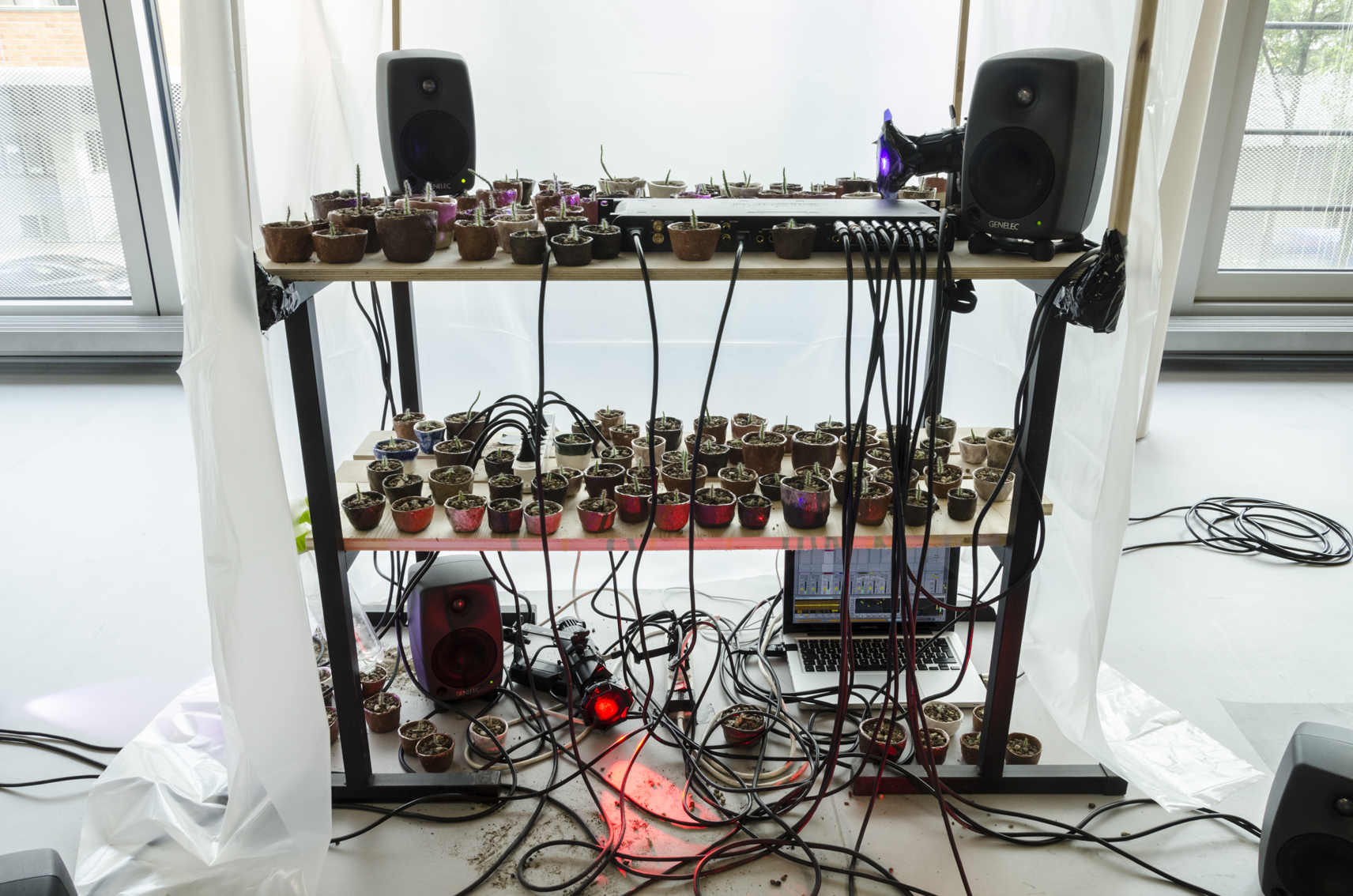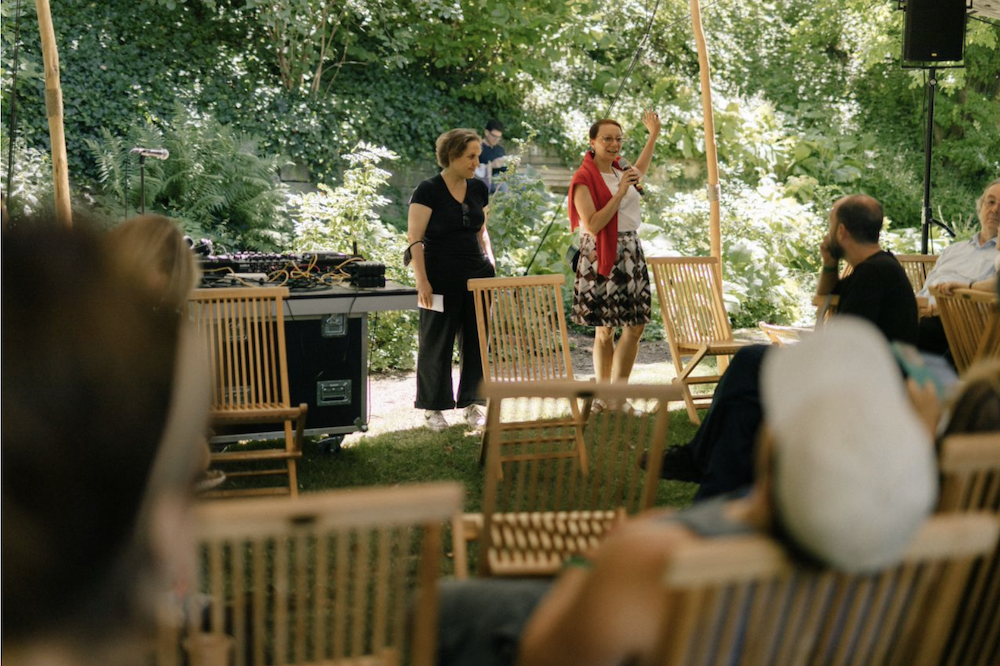Die Zürcher Klangkünstlerin und Musikerin Magda Drozd setzt sich in Beziehung zu den Klängen und Wesen ihrer Umwelt. Dabei arbeitet sie genauso erkenntnisgeleitet und reflektiert wie spekulativ und fantastisch. Im Frühjahr 2023 erschien ihr drittes Album „Viscera“. Derweil komponiert sie Musik für Theater und Hörspiel und tritt auch als Solo-Performin in experimentellen Soundkontexten zwischen den Szenen in Erscheinung.
Friedemann Dupelius
Welche Musik würde eine Aloe Vera hören? Wozu möchte der Gummibaum im Wohnzimmer tanzen? Wäre die Playlist des Kaktus auf dem Fenstersims gespickt mit Piek Time Hits? Darüber können wir nur spekulieren. Die Zürcherin Magda Drozd hat ein ganzes Album darüber geschrieben: „Songs for Plants“ erschien Ende 2019 auf dem Luzerner Label „Präsens Editionen“ und passte nur zu gut in die Zeit, in der gefühlt alle zu Heimgärtner:innen mutierten.

Ausgangspunkt war ein Kunstprojekt, das für Magda Drozd zunächst darin bestand, 200 Kakteen zu züchten. Zwei Jahre später war eine Klanginstallation daraus gewachsen: „Intra-Action / Traces“. An der Zürcher Hochschule der Künste (ZHdK) besuchte die Künstlerin das von Marcus Maeder initiierte „treelab“. Dort fand sie die technischen Behelfsmittel, um die Klänge unterschiedlichster Pflanzen hörbar zu machen. Eine feine Nadel nimmt die Bewegungen von Flüssigkeiten in den Kapillaren (quasi den Adern) der Pflanzen ab. Mehrere Verstärker und eine Software transponieren das Innere der Pflanze dann in den menschlichen Hörbereich. Je durstiger eine Pflanze ist, desto mehr Luftblasen bewegen sich in ihren Kapillaren und desto lauter sind ihre nun klickartigen Laute.
Klänge zwischen Kapillaren und Spiel
Magda Drozd interessierte sich nicht nur für die Bioakustik der Kakteen, sondern auch für ihre eigene Position als Mensch in Bezug auf diese so andersartigen Lebewesen. Dabei ist ihr klar, dass bereits der Schritt der Transponierung ein künstlicher Kniff ist. „Ich repräsentiere die Pflanzen nicht und versuche auch nicht, so gut wie möglich ihren Klang darzustellen. Es ist letztendlich ein Spiel mit dem Material.“
Magda Drozd · Weaving into shores: Die Klanginstallation „Weaving into shores“ kombiniert Aufnahmen vom Zürichsee mit Drones aus Synthesizern und von der Violine. Wie hören wir dem See zu? Was bedeutet er für uns?
Mit den fertigen Kaktus-Instrumenten trat Magda Drozd nun ins Spiel. Sie goss die Gewächse, hörte auf deren Reaktion und bezog auch die Klänge der Erde und Keramik, wenn sie diese berührte, mit ein. „Daraus entsteht erst mal ein Klangteppich. Ich arbeite dann viel mit Frequenzverschiebungen. Unterschiedliche Aufnahmen verändere ich so, dass man nur noch eine Frequenz hört. Dann lege ich Effekte darüber und langsam entsteht aus dem Material, das nur vermeintlich die Pflanze ist, Musik.“ Diese speist sich auch aus Rhythmen oder Melodien, die sich aus den Kapillar-Klängen erkennen lassen, und die Drozd mit Synthesizern oder ihrem Herzensinstrument – der Geige – weiterspinnt. Nicht ohne Grund heißt das resultierende Album dann auch „Songs for Plants“ und nicht „Songs by Plants“.
„Painkiller“ vom Album „Songs for Plants“
Magda Drozd wurde 1987 in Polen geboren, wuchs in München auf und zog 2011 nach Zürich, um Theater-Dramaturgie und später Bildende Kunst an der Zürcher Hochschule der Künste zu studieren. Von Theater und Performance fand sie den Weg zur Klangkunst und der experimentellen Musik. Die verschiedenen Kunstformen und ihre Formate durchdringen und vermischen sich in ihren Arbeiten. Von 2019 bis 2021 war sie „Research Fellow“ an der ZhdK und beschäftigte sich mit Klang und Hören als Mittel der Wissensproduktion. In diese Zeit fiel auch die Arbeit an ihrem zweiten Album „18 Floors“. Der Titel bezieht sich auf das Lochergut-Hochhaus in Zürich, in dem die Künstlerin damals wohnte. Sie horchte das Gebäude und seine 18 Stockwerke in allen (ihr zugänglichen) Nischen und Winkeln ab und hielt viele Hörmomente in Fieldrecordings fest. Daraus ergaben sich Fragen wie: Was heißt urbanes Zusammenleben auf engstem Raum? Inwiefern kann man ein Wohngebäude als lebendigen Organismus verstehen? Welches Wissen kann aus genauem Hinhören an einem Ort generiert werden?“
„Dreamy Monster“ vom Album „18 Floors“
Hören zwischen Erkenntnis und Spekulation
„Wissen, das sich über Sound vermittelt, ist ein anderes Wissen als das, was wir für gewöhnlich gelten lassen. Es ist fragil, fluide und ephemer. Und es führte mich bald zur Spekulation. Ich habe ja nicht die Gespräche in diesem Haus aufgenommen, sondern seine harten Materialien.“ So ist „18 Floors“ zugleich die Dokumentation eines minutiösen, erkenntnisgeleiteten Hörprozesses – und die in Musik gefasste Spekulation über all die Geschichten, Wesen und geheimen Abläufe, die ein Betongebäude in sich birgt. „Mir ging es nicht darum, jeden Sound einer bestimmten Ecke oder Etage in dem Haus zuzuordnen. Ich habe vieles vermischt. Das ist für mich diese Spekulation: Es entsteht etwas Neues, das unsere Fantasie anregt: Okay, auch das kann ein Haus sein, auch so kann es klingen. Dabei geht es auch darum, durch das Hören empathisch zu werden, durch die Musik auch einen emotionalen Zugang zu einem möglichen Wissen zu bekommen.“ Zunächst sollte „18 Floors“ die Gestalt einer konzeptuellen Performance annehmen. Dass daraus ein Musikalbum wurde hat Magda Drozd der Klangkünstlerin und -forscherin Salomé Voegelin zu verdanken, mit der sie in engem Austausch stand.

Mit ihren Arbeiten bewegt sich Magda Drozd in verschiedenen Disziplinen und Formaten: Soundinstallation, Theaterperformance, Hörspielmusik, Komposition, Forschung. „Ich bewege mich zwischen den Szenen und fühle mich da auch wohl. Das ist auch manchmal anstrengend, aber je länger ich aktiv bin, desto mehr wissen die Leute, was ich mache.“
Die Leute, die sie schon sehr lange kennen – namentlich ihre deutschen Freund:innen – sagen, Magda spräche mittlerweile in Schweizer Sprachmelodie. Das will sie so nicht stehen lassen – und auch im Gespräch mit ihr erkennt das am Süddeutschen geschulte Autorenohr nichts dergleichen. Aber vielleicht ist auch etwas dran: Zwischen und über all die herausfordernden, forschenden, schwebenden und schürfenden Soundpassagen schieben sich immer wieder Melodien – das ist selten genug in experimenteller, an Klangkunst orientierter Musik. „Ich habe keine Angst vor ein bisschen Kitsch oder emotionalen Momenten. Für mich spiegelt sich darin das Leben wieder: Es gibt Ecken und Kanten, und es gibt die runden Momente, in denen man sich von einer Melodie treiben lassen kann. Wenn ich dabei die Geige benutze ist es immer eine feine Gratwanderung, nicht zu pathetisch zu werden. Generell glaube ich, dass Melodien auch in experimenteller Musik wieder mehr im Trend liegen.“
Magda Drozd: Clipped Wings vom Album Viscera
Am Unverblümtesten hört man sie in Magda Drozds neuestem Album „Viscera“. Auch hier eröffnet der Titel wieder spekulative Räume. Musik für Eingeweide? Der Klang des Körpers? Oder vielleicht diesmal: „Songs for Humans“? Es darf weiter spekuliert werden.
Friedemann Dupelius
Konzerte & Performances
20.+23.06.23 – Musik für Charlotte Mathiessen: Der Boden ist verhältnismässig hart – ein performativer Spaziergang oder ein Protestmarsch (ZHdK Zürich)
08.07.23 – Musik für die Performance „Warp“ von Nicola Genovese (Fondazione Teatro, Lugano)
Mit Katja Brunner als Paula Rot (Spoken Word trifft auf Sound Scape):
24.06.23 – Sofalesungen, Basel
09.07.23 – Hinterhalt-Festival, Uster
Solo-Konzerte
19.08.23 – Les Digitales, Luzern
25.08.23 – Natures of Pop Festival, ZHdK Zürich
09.09.23 – Les Digitales, Biel
Magda Drozd
Songs for Plants (Präsens Editionen, 2019)
18 Floors (Präsens Editionen, 2021)
Viscera (Präsens Editionen, 2023)
neo-Profile:
Magda Drozd

